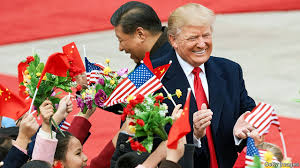The Trump administration plans to crack down on Chinese investment

PRESIDENT Donald Trump’s view of investment depends on who is doing it. On June 22nd he railed against Europeans exporting cars to America, demanding that they “build them here!” On June 26th he tweeted that all Harley-Davidson motorcycles should be made in America (see article). But when it comes to Chinese investors buying American technology, Mr Trump would prefer a frostier approach.
Investors have feared a clampdown since March, when the administration concluded that China’s unfair actions against American companies merited retaliatory restrictions on Chinese investments in “industries or technologies deemed important to the United States”. Mr Trump directed Steven Mnuchin, the treasury secretary, to come up with options. On June 24th it appeared policy might tighten dramatically, with reports of plans to limit investment in America in the sectors targeted by China’s “Made in China 2025” development policy, from aerospace to robotics.
Those plans were quickly shelved, perhaps because of market falls on June 25th. On June 27th the White House confirmed that there would be no new China-specific restrictions. Instead, it would rely on the Committee on Foreign Investment in the United States (CFIUS), an intra-agency committee that reviews inbound investment. Mr Trump also told the Commerce Department to review export controls.
What might look like a non-event is in fact an attempt to avoid a duplication of effort. Both America’s inbound-investment restrictions and its export controls are being beefed up by the Foreign Investment Risk Review Modernisation Act (FIRRMA), a bill with bipartisan support that should become law in the coming months. It would expand CFIUS’s scope of review and strengthen controls on exports of technologies deemed particularly sensitive. A version was approved overwhelmingly by the House of Representatives on June 26th.
So the Trump administration’s decision not to set up new constraints does not signal a change of heart towards China. Rather, it reflects a desire shared with Congress to block Chinese cash. China’s share of direct investment into America is still small, but has risen quickly (see chart). Of $ 137bn in the ten years up to 2017, 24% was invested by state-owned enterprises, fuelling widespread concern that the purchases are part of a Chinese government strategy to dominate America economically.
That concern has been reflected in CFIUS’s activities. Of the 387 transactions it reviewed between 2013 and 2015, 74 involved Chinese investors. Of the five transactions it has ever recommended to be blocked, four involved Chinese buyers. Investment from China has already fallen from its peak in 2016, pulled down by Chinese capital controls and tougher American scrutiny. Since FIRRMA was drafted with China in mind, opportunities for such scrutiny will only increase.
Historically, Congress has not been shy about calling for a tough approach towards America’s economic rivals. CFIUS was set up in the 1970s in response to concerns that members of OPEC, the oil producers’ cartel, were hoovering up American assets for political ends. Congress granted the president authority to review investments in the 1980s, amid fears over Japan’s economic rise and its firms’ attempts to buy up American makers of semiconductors. The first set of concerns has since faded; the second now focuses on China.
But policymakers have tried to avoid discouraging investment in America. In the 1980s Ronald Reagan fought against broadening the scope of CFIUS to include “essential commerce” as well as “national security”. Handing the power of approval to the president rather than Congress was supposed to depoliticise the process, and so protect ordinary businesses.
Today, as Mr Trump seems eager to hit China where it hurts, these roles may be reversed. Congress has softened the most draconian parts of the bill. An earlier version of FIRRMA would have led to CFIUS being able to review any outbound transfer of intellectual property between companies in joint ventures or licensing deals. But it was pared back after companies voiced fears that this could interfere with their everyday operations, by leaving even the most vanilla transactions exposed to a cumbersome review process.
New, vaguely worded China-specific restrictions from the administration could have increased the uncertainty swirling around multinationals. In the run-up to June 27th, some had worried that ordinary cross-border business could be hit. Could an engineer sharing information with another in a foreign subsidiary count as a transfer of America’s intellectual resources? The news that Mr Trump’s push for investment restrictions had narrowed to CFIUS and FIRRMA, therefore, was a relief to some. When it became public, the S&P 500 ticked up.
This article appeared in the Finance and economics section of the print edition under the headline “Safe and secure”







